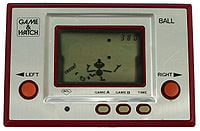Game & Watch (universe)
- "Game & Watch" redirects here. For the character from the Game & Watch series, see Mr. Game & Watch.
| Game & Watch (universe) | |
|---|---|
 File:Game&WatchSymbol.png | |
| Developer(s) | Nintendo |
| Publisher(s) | Nintendo |
| Designer(s) | Gunpei Yokoi |
| Genre(s) | Minigame |
| Console/platform of origin | Game & Watch |
| First installment | Ball (1980) |
| Latest installment | Game & Wario (2013) |
The Game & Watch universe refers to the Smash Bros. series' collection of characters, stages, and properties concerning and modeled off of Nintendo's old Game & Watch series of dedicated handheld gaming devices, released from 1980 to 1991. The series popularized handheld electronic entertainment and set up for Nintendo's later Game Boy line of portable consoles. For predating even 1981's Donkey Kong, the Game & Watch series is sometimes labeled a critical forerunner in Nintendo's modern video game business. The Smash Bros. series debuted an original character representing the series as a unique and distinctive "mascot", Mr. Game & Watch, and included him as a playable character in Melee and Brawl.
Franchise description
Even before Nintendo's future as a leading competitor in the video game market was shaped by the breakout video arcade hit that was the original Donkey Kong in 1981, the company had been finding some small success in the video arcade game industry since 1975. During this timeframe, one of Nintendo's first game designers, Gunpei Yokoi, is said to have realized the appeal of a portable device that doubled both as a watch and as a miniature game machine when he watched another passenger riding a Shinkansen bullet train using an LCD calculator as a means of passing the time. As head of Nintendo's "Nintendo Research & Development 1" team, Yokoi developed and released the first entry in what became a long-running line of dedicated handhelds under the Game & Watch name, Ball / Toss-Up, near the end of April 1980. As per the definition of a dedicated console, each Game & Watch device was a handheld with a single built-in game, and what became a long-running series of Game & Watch portables initially displayed very basic monochrome graphics on Liquid-Crystal Display screens. Also, as per the title of the product line, each game doubled as an electronic timepiece. A total of 59 Game & Watch games were developed and released between 1980 and 1991, including some games released after Yokoi's more famous handheld creation, the Game Boy.
The first Game & Watch game became the earliest Nintendo product to garner major success, even before the industry-defining success of Donkey Kong just a year later, and the entire series sold over 43 million copies. The series is credited with making handhelds vastly popular and setting up for Nintendo's future handheld console business with the Game Boy line, as well as inspiring various other toy companies, most notably Tiger Electronics, to create their own dedicated handhelds. The series of dedicated handhelds gradually became more technologically advanced over the years and went through several different models that were designed to deliver some more creative twists to each individual game, including a clam-shell design with two separate screens displaying graphics simultaneously. As many modern retrospectives note, this particular "Multi-Screen" design was a forerunner to Nintendo's modern dual-screened handheld platforms, the DS and the 3DS, and bore a very close resemblance.
The Game & Watch products themselves initially depicted cartoon-shaped characters resembling black silhouettes on white backgrounds, but as the series went on, they released several games based on external IPs unrelated to Nintendo: Disney's Mickey Mouse and the Popeye and Peanuts comic strips. Starting from 1982, Game & Watch titles also began depicting Mario and Donkey Kong characters as Nintendo's business in video games took hold, and near the end of the series' release history, Balloon Fight and The Legend of Zelda also made incidental releases in handheld Game & Watch form. After the line was retired in 1991, Nintendo began to make occasional references to, and ports of, the Game & Watch brand; in between 1997 and 2002, four installments of a Game Boy / Game Boy Advance series called Game & Watch Gallery were released, each compiling several of the original games and offering them both in their original monochrome appearances and with "remade" versions featuring Mario characters and settings. More famously, a collective representation of the various black-silhouetted characters seen throughout the earlier games, Mr. Game & Watch, debuted as a surprise playable character in 2001's Super Smash Bros. Melee. After the success of Melee, Nintendo put cameos of this character in several other games, such as both Wario Land 4 and the WarioWare series, and Donkey Kong Country Returns as well. Mr. Game & Watch also reprised his role in Super Smash Bros. Brawl, with an important plot relevance in the game's story mode.
In Super Smash Bros. Melee
Game & Watch is a franchise first introduced in the Smash series in Melee, featuring one character and one stage.
Character
- Mr. Game & Watch: A small, flat, black, and voiceless personality who made several appearances among several of the games in the Game & Watch series, Mr. Game and Watch was given his identity for his appearance as a Melee fighter. A character like no other in the Smash series, Mr."G&W" is almost totally flat, and nearly every movement he makes is distinctively frame-by-frame and is accompanied by a "beep-and-boop" sound. As a Melee fighter, he is also unique in his side special move, Judgement, which creates a random effect that can be powerful, but may actually hurt him at times, and the bucket from his Oil Panic move collects projectiles thrown at him; when three projectiles are gathered, their accumulated damage and knockback is dealt the next time he whips out his bucket and there is an opponent in his way.
Stage
Melee features one stage based, quite literally, on the Game & Watch platform.
- Superflat World: Flat Zone: This stage takes place in the screen of a giant old-style Game & Watch platform, where the characters appear 3D but can seem to reside in a flat space. Visual elements of its layout are combined from elements of the Game & Watch entries named Manhole, Helmet, and Oil Panic. It has several platforms and one small house rooftop to the right, and various hazards such as spilled oil on the ground and falling tools from the sky complicate the action. This could be the smallest and most cramped stage in the game, with the left, right, and upper KO boundaries all rather close to the edges of the visible screen. This makes for a stage not often allowed in tournaments. However, it is always fought as the last stage in All-Star Mode (where the opponents are 25 Mr. Game & Watches), and it is the stage where Mr. Game & Watch's Target Test challenge takes place as well.
Music
- 26: Flat Zone: An original composition comprised of atmospheric techno-sounds mixed with the bleep noises of the oldest Game & Watch games. It appears in Flat Zone.
- 49: Mr. Game & Watch's Victory: The victory fanfare of Mr. Game & Watch is an original composition with the same influence as track 22, "Flat Zone".
Full Trophy List
- Mr. Game & Watch's three game trophies
- Game & Watch
In Super Smash Bros. Brawl
Mr. Game & Watch was confirmed to return in Super Smash Bros. Brawl on the DOJO!! after Brawl was released in North America.
Character
- Mr. Game & Watch: Not dramatically changed from Melee, he is an unlockable character. His Final Smash allows him to transform into the giant octopus from Octopus and extend his tentacles.
On the final character select screen (after all characters are unlocked), Mr. Game & Watch occupies the ninth column (miscellaneous characters) along with Snake, Sonic, and the random option.
Stage
- Flat Zone 2: Like its predecessor Flat Zone from Melee, this stage is set in a giant widescreen Game & Watch called "Super Smash Bros". Unlike Flat Zone, its layout alternates between the games Fire, Oil Panic, Chef, and Lion.
Music
- Flat Zone 2 - Much like the Flat Zone music from Melee, this track is constructed out of various sound effects from the Game & Watch games, but has a decidedly different ambiance than the previous one, with the track being mainly composed of by Game & Watch sound effects, rather than having them dully in the background. It is used on the Flat Zone 2 stage. This song also plays during Mr. Game & Watch's Classic Mode credits.
- Flat Zone (Melee) - Taken directly from Melee. It is used on the Flat Zone 2 stage.
- Mr. Game & Watch's victory theme - An original victory fanfare made of various Game & Watch sound effects. It is completely different from his Melee victory theme.
Trophies
Stickers
Super Smash Bros. 4
The Game & Watch series makes a return in Smash 4 with his stage from Brawl returning in the 3DS version.
Character
Mr. Game & Watch: He returned mostly unchanged from Brawl including his "Octopus" Final Smash but with some light buffs in attack and speed to make up for it.
Stage
Flat Zone 2: remains mostly unchanged from Brawl.
Trivia
- The Game & Watch universe has the fewest trophies in both Melee and Brawl.
|
| |
|---|---|
| Fighter | Mr. Game & Watch (SSBM · SSBB · SSB4 · SSBU) |
| Stages | Flat Zone · Flat Zone 2 · Flat Zone X |
| Trophies, Stickers and Spirits | Trophies (SSBM · SSBB · SSB4) · Stickers · Spirits |
| Music | Flat Zone · Flat Zone 2 |
| Nintendo consoles | |
|---|---|
| Home consoles | Color TV-Game 15 · Nintendo Entertainment System · Super Nintendo Entertainment System · Virtual Boy · Nintendo 64 · Nintendo GameCube · Wii · Wii U |
| Handheld consoles | Game & Watch · Game Boy · Game Boy Color · Game Boy Advance · Nintendo DS · Nintendo 3DS |
| Hybrid consoles | Nintendo Switch |
